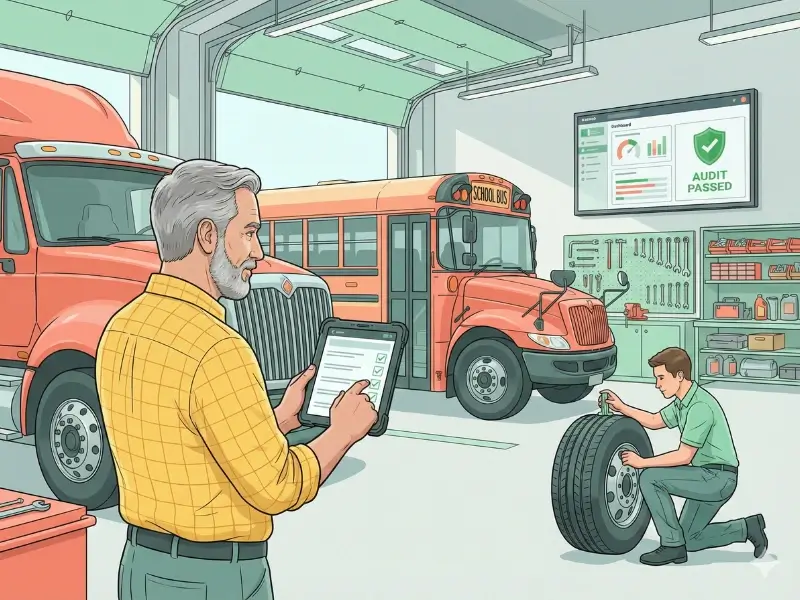Key Takeaways
Keeping your fleet compliant with Department of Transportation (DOT) regulations can feel like a full-time job. With the constant pressure of meeting complex requirements and the ever-present threat of hefty fines for non-compliance, managing DOT inspections is one of the most challenging tasks for fleet managers. But while it may seem overwhelming, with the right approach and tools, you can ensure that your vehicles pass every DOT inspection smoothly.
Here’s how you can navigate the tricky waters of fleet compliance, stay on top of regulatory pressure, and keep your vehicles inspection-ready at all times.
1. Understand the DOT Requirements Inside Out
The first step to passing any inspection is knowing what the DOT looks for. DOT inspections cover a range of areas, from vehicle maintenance to driver logs. Some of the key areas you’ll need to focus on include:
- Vehicle Safety: This includes things like brakes, lights, tires, and steering. Any wear and tear on these critical components can lead to a failed inspection.
- Driver Qualifications: Make sure your drivers have the correct licenses, medical certificates, and are compliant with hours of service regulations.
- Vehicle Maintenance Records: The DOT requires detailed records of all maintenance activities. Keeping these up to date is crucial.
While understanding the regulations is a time-consuming task, it’s essential. If you’re not sure where to start, consulting the DOT’s guidelines or hiring a compliance expert can help you get up to speed.
2. Keep Up with Regular Maintenance: Prevent Problems Before They Happen
One of the simplest yet most effective ways to ensure compliance is to stay on top of your vehicle maintenance. DOT inspections focus heavily on the condition of your fleet, so addressing maintenance issues before they become major problems can save you a lot of headaches.
Having a solid preventive maintenance plan in place ensures that things like brakes, tires, lights, and other essential systems are always in good working order. Regular inspections of your vehicles by your own team can help you spot small issues before they become DOT violations.
Consider using fleet management software to track maintenance schedules. These tools can send reminders when service is due, helping you stay proactive and reducing the risk of breakdowns or failures during a DOT inspection.
3. Maintain Accurate and Complete Documentation
DOT inspectors will ask for a variety of documents during an inspection, including maintenance records, driver logs, and proof of insurance. It’s crucial to make sure all of your paperwork is up to date and readily available.
Here’s a quick list of documents you’ll need to keep in order:
- Driver logs (ensuring compliance with hours of service regulations)
- Vehicle inspection reports
- Maintenance and repair records
- Licensing and certification documents
Being organized is key to passing DOT inspections. If an inspector asks for a specific record and you can’t find it quickly, it could raise red flags, even if your fleet is in top condition.
Download Your Free Fleet Inspection Resources Now!
4. Train Your Drivers on Compliance
Drivers are the front line of your fleet, so they need to be fully trained on DOT requirements and how to maintain compliance. Not only should they know the rules and regulations they are expected to follow, but they should also understand why compliance is so critical.
Train your drivers to spot potential issues with their vehicles before they become serious can help keep your fleet in compliance. For example, encouraging drivers to conduct thorough pre-trip inspections ensures that afuny problems are caught and fixed before they hit the road.
Additionally, drivers should be aware of the hours of service (HOS) rules. Violations here can lead to costly penalties, so ensuring that your drivers log their hours accurately and follow rest requirements is essential.
5. Stay Current with Regulatory Changes
Compliance isn’t static. DOT and other regulatory bodies, like the Environmental Protection Agency (EPA), frequently update their rules, and staying on top of these changes is a major challenge. But keeping yourself informed about the latest requirements can save you from fines and non-compliance issues.
Consider subscribing to industry newsletters or using compliance software that updates you on any changes in regulations. This will help you adjust your fleet operations as needed and ensure you’re always meeting the latest standards.
6. Use Fleet Management Software to Stay Organized
Trying to manage compliance manually can quickly become overwhelming. That’s why many fleet managers turn to fleet management software to help streamline the process. These tools are designed to handle the heavy lifting when it comes to tracking maintenance, logging hours of service, and keeping records organized.
With fleet management software, you can:
- Track vehicle maintenance schedules and get alerts when service is due.
- Keep digital records of all maintenance, repairs, and inspections.
- Automatically log driver hours and ensure they’re within legal limits.
- Stay updated on changing regulations and requirements.
By automating these tasks, you reduce the risk of something slipping through the cracks and causing compliance issues.
7. Conduct Internal Audits
Before a DOT inspector shows up, it’s a good idea to conduct your own internal audits. These audits help you identify any areas where you might be falling short so that you can address them before they become a problem.
Check your vehicles for any safety issues, make sure your records are complete, and review your drivers’ logs for any potential violations. Catching these issues early gives you time to fix them and ensures that you’re always prepared for an inspection.
8. Handle Violations Swiftly
Even with the best preparation, there’s always a chance something could go wrong. If you do receive a violation, it’s important to handle it swiftly and efficiently. Take immediate steps to address the problem and document everything you do to resolve it.
By responding quickly, you not only reduce the impact of the violation but also show the DOT that you’re committed to maintaining compliance.
Stay Compliant and Stress-Free with Simply Fleet!
Managing fleet compliance with DOT and other regulations can be complex and time-consuming, but with the right systems in place, it doesn’t have to be overwhelming. With a little preparation and the right tools, you can deal with regulatory pressure and keep your fleet on the road, compliant, and ready for the next job.
Simply Fleet's Fleet Management Software is here to help! From tracking maintenance schedules and monitoring driver behavior to keeping your records organized, Simply Fleet makes it simple to stay on top of DOT and EPA regulations. Avoid costly fines and downtime with real-time alerts, automated reports, and a user-friendly dashboard that keeps everything in one place. Streamline your operations and take control of your fleet’s performance today. Get started with Simply Fleet and make compliance stress-free!



.png)








.png)


.png)



.webp)




